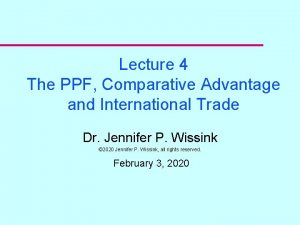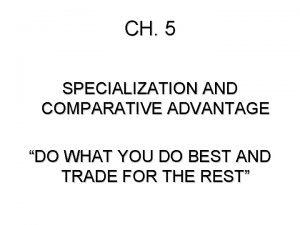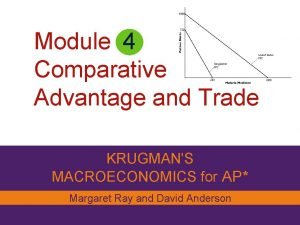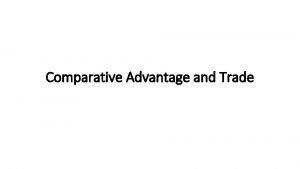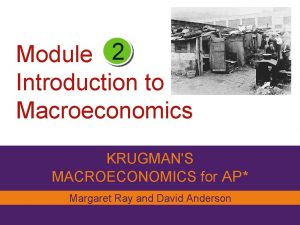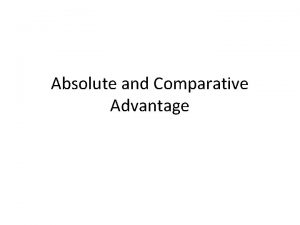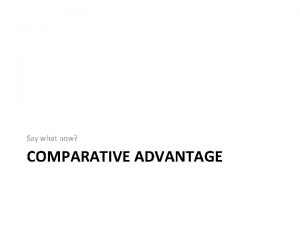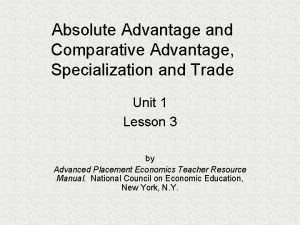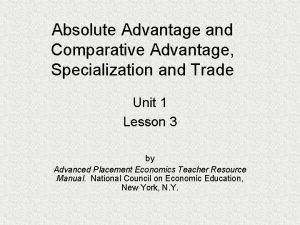4 Module Comparative Advantage and Trade KRUGMANS MACROECONOMICS









- Slides: 9

4 Module Comparative Advantage and Trade KRUGMAN'S MACROECONOMICS for AP* Margaret Ray and David Anderson

What you will learn in this Module: • How trade leads to gains for an individual or an economy • The difference between absolute advantage and comparative advantage • How comparative advantage leads to gains from trade in the global marketplace

Gains from Trade • Gains from trade • Specialization • The importance of markets

Comparative Advantage and Gains from Trade • Comparative Advantage (input) • Terms of Trade • Absolute Advantage (output)

Production Possibilities for Two Countries

Production Possibilities for Two Countries Will these two countries gain from trade if 100 units of malaria medicine are traded for 200 cotton shirts? To find out: 1. Calculate the opportunity costs of production for each country 2. Determine the comparative advantage for each country 3. Determine if the terms of trade are mutually beneficial

Production Possibilities for Two Countries Bangladesh United States Cotton Shirts (C) 750 C = 250 M 1 C = 1/3 M 1000 C =1000 M 1 C = 1 M Malaria Medicine (M) 250 M = 750 C 1 M = 3 C 1000 M =1000 C 1 M = 1 C

Production Possibilities for Two Countries Bangladesh United States Cotton Shirts (C) 750 C = 250 M 1 C = 1/3 M 1000 C =1000 M 1 C = 1 M Malaria Medicine (M) 250 M = 750 C 1 M = 3 C 1000 M =1000 C 1 M = 1 C The United States has a comparative advantage in Malaria Medicine (M) because they only give up 1 cotton shirt while Bangladesh must give up 3 cotton shirts to gain 1 unit of medicine. Bangladesh has a comparative advantage in Cotton Shirts (C) because they only give up 1/3 unit of medicine while The United States must give up 1 unit of medicine to gain 1 cotton shirt.

Production Possibilities for Two Countries The terms of trade are mutually beneficial as long as they are between the two countries’ opportunity costs. Bangladesh United States Cotton Shirts (C) 750 C = 250 M 1 C = 1/3 M 1000 C =1000 M 1 C = 1 M Malaria Medicine (M) 250 M = 750 C 1 M = 3 C 1000 M =1000 C 1 M = 1 C For example, any amount of medicine greater than 1/3 and less than 1 traded for 1 cotton shirt would represent mutually beneficial terms of trade. Likewise, any number of cotton shirts greater than 1 and less than 3 traded for 1 unit of medicine would represent mutually beneficial terms of trade.
 Krugman ap economics
Krugman ap economics Comparative advantage ppf
Comparative advantage ppf Actual mechanical advantage vs ideal mechanical advantage
Actual mechanical advantage vs ideal mechanical advantage Trade diversion and trade creation
Trade diversion and trade creation Umich
Umich Trade diversion and trade creation
Trade diversion and trade creation Trade diversion and trade creation
Trade diversion and trade creation Tramp and liner shipping
Tramp and liner shipping Specialization and comparative advantage
Specialization and comparative advantage When discussing comparative and absolute advantage
When discussing comparative and absolute advantage

